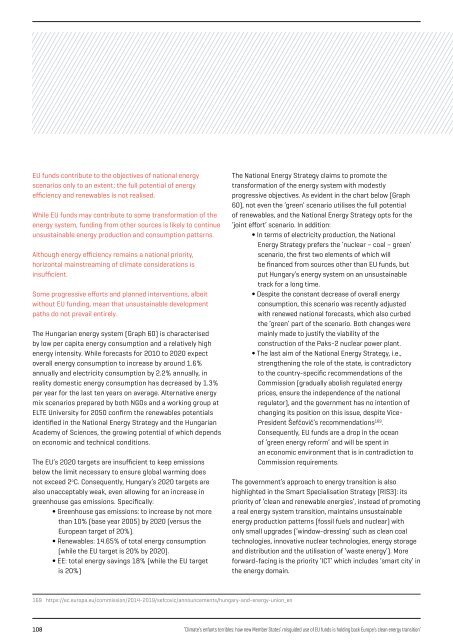ENFANTS TERRIBLES
enfants-terribles
enfants-terribles
Create successful ePaper yourself
Turn your PDF publications into a flip-book with our unique Google optimized e-Paper software.
EU funds contribute to the objectives of national energy<br />
scenarios only to an extent; the full potential of energy<br />
efficiency and renewables is not realised.<br />
While EU funds may contribute to some transformation of the<br />
energy system, funding from other sources is likely to continue<br />
unsustainable energy production and consumption patterns.<br />
Although energy efficiency remains a national priority,<br />
horizontal mainstreaming of climate considerations is<br />
insufficient.<br />
Some progressive efforts and planned interventions, albeit<br />
without EU funding, mean that unsustainable development<br />
paths do not prevail entirely.<br />
The Hungarian energy system (Graph 60) is characterised<br />
by low per capita energy consumption and a relatively high<br />
energy intensity. While forecasts for 2010 to 2020 expect<br />
overall energy consumption to increase by around 1.6%<br />
annually and electricity consumption by 2.2% annually, in<br />
reality domestic energy consumption has decreased by 1.3%<br />
per year for the last ten years on average. Alternative energy<br />
mix scenarios prepared by both NGOs and a working group at<br />
ELTE University for 2050 confirm the renewables potentials<br />
identified in the National Energy Strategy and the Hungarian<br />
Academy of Sciences, the growing potential of which depends<br />
on economic and technical conditions.<br />
The EU’s 2020 targets are insufficient to keep emissions<br />
below the limit necessary to ensure global warming does<br />
not exceed 2 o C. Consequently, Hungary’s 2020 targets are<br />
also unacceptably weak, even allowing for an increase in<br />
greenhouse gas emissions. Specifically:<br />
• Greenhouse gas emissions: to increase by not more<br />
than 10% (base year 2005) by 2020 (versus the<br />
European target of 20%).<br />
• Renewables: 14.65% of total energy consumption<br />
(while the EU target is 20% by 2020).<br />
• EE: total energy savings 18% (while the EU target<br />
is 20%)<br />
The National Energy Strategy claims to promote the<br />
transformation of the energy system with modestly<br />
progressive objectives. As evident in the chart below (Graph<br />
60), not even the ‘green’ scenario utilises the full potential<br />
of renewables, and the National Energy Strategy opts for the<br />
‘joint effort’ scenario. In addition:<br />
• In terms of electricity production, the National<br />
Energy Strategy prefers the ‘nuclear – coal – green’<br />
scenario, the first two elements of which will<br />
be financed from sources other than EU funds, but<br />
put Hungary’s energy system on an unsustainable<br />
track for a long time.<br />
• Despite the constant decrease of overall energy<br />
consumption, this scenario was recently adjusted<br />
with renewed national forecasts, which also curbed<br />
the ’green’ part of the scenario. Both changes were<br />
mainly made to justify the viability of the<br />
construction of the Paks-2 nuclear power plant.<br />
• The last aim of the National Energy Strategy, i.e.,<br />
strengthening the role of the state, is contradictory<br />
to the country-specific recommendations of the<br />
Commission (gradually abolish regulated energy<br />
prices, ensure the independence of the national<br />
regulator), and the government has no intention of<br />
changing its position on this issue, despite Vice-<br />
President Šefčovič’s recommendations 169 .<br />
Consequently, EU funds are a drop in the ocean<br />
of ‘green energy reform’ and will be spent in<br />
an economic environment that is in contradiction to<br />
Commission requirements.<br />
The government’s approach to energy transition is also<br />
highlighted in the Smart Specialisation Strategy (RIS3): its<br />
priority of ‘clean and renewable energies’, instead of promoting<br />
a real energy system transition, maintains unsustainable<br />
energy production patterns (fossil fuels and nuclear) with<br />
only small upgrades (‘window-dressing’ such as clean coal<br />
technologies, innovative nuclear technologies, energy storage<br />
and distribution and the utilisation of ‘waste energy’). More<br />
forward-facing is the priority ‘ICT’ which includes ‘smart city’ in<br />
the energy domain.<br />
169 https://ec.europa.eu/commission/2014-2019/sefcovic/announcements/hungary-and-energy-union_en<br />
108<br />
‘Climate’s enfants terribles: how new Member States’ misguided use of EU funds is holding back Europe’s clean energy transition’


